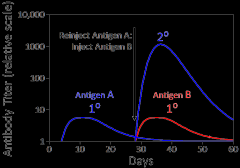![]()
![]()
![]()
Use LEFT and RIGHT arrow keys to navigate between flashcards;
Use UP and DOWN arrow keys to flip the card;
H to show hint;
A reads text to speech;
21 Cards in this Set
- Front
- Back
|
Overall, the immune response can be divided into what two major classifications? |
The two major classifications of the immune response are humoral and cell mediated responses. |
|
|
Define Antigen (Ag) and give the four specific examples that aid in the definition. |
An antigen is a molecule which elicits specific immune responses when introduced into an animal. More specifically, antigenic substances are: 1) Large >10,000 Da |
|
|
Define Antibody (Ab) |
A glycoprotein produced in response to an antigen, that is specific for the antigen, and binds to it through noncovalent interactions. |
|
|
What is the difference between an immunoglobulin and an antibody? |
An immunoglobulin describes ANY antibody regardless of specificity and comes in different forms (IgA IgD IgE IgG IgM) that reflect their form. An antibody describes an antigen-specific immunoglobulin. |
|
|
What do "antibody kinetics" prove? |
1. The immune response is specific. |
|

Be able to describe |
This graph represents antibody kinetics. The x axis is a measure of time (days) and the y axis is a measure of the antibody titer (measure of the amount of antibody in the animal's serum per unit volume) This figure represents the production of antibody in response to antigenic substances. The animal was injected with antigen A at day 0. Antigen A invokes a primary response beginning around day four and thus the antibody is mainly IgM and some IgG. After a peak titer, the response decreases rapidly. If the animal is re-injected with antigen A the production of antibody begins almost immediately and reaches a level of 1000 fold greater than seen in the primary response, and hence this is a secondary response (primarily IgG). If the animal is injected with Antigen B the body will only produce a primary response to this antigen. |
|
|
What is the clonal selection hypothesis? |
1. Animals contain numerous cells called lymphocytes. 3. Upon contacting its appropriate antigen, the lymphocyte is stimulated to proliferate (clonal expansion) and differentiate. |
|
|
Describe the surface components of B-lymphocytes and their corresponding function. |
1) Surface immunoglobulin = direct antigen recognition 3) Class II Major Histocompatabilty Complex (MHC) molecule = antigen presentation |
|
|
Describe the surface components of T-lymphocytes and their corresponding function. |
1) CD3 molecule = involved in both humoral and cell mediated responses 2) T-cell receptor = antigen recogniton |
|
|
What are the three specific types of T-lymphocytes? |
Helper T cells, Cytotoxic T cells and Suprressor T cells |
|
|
Describe the surface components unique to Helper T Cells and their function. |
CD4 molecule: 2) Promotes differentiation of B-cells and cytotoxic T-cells 3) Activates macrophages |
|
|
Describe the surface component unique to Suppressor T Cells and it's function. |
CD8 molecule: |
|
|
Describe the surface components unique to Cytotoxic T Cells and their function. |
CD8 molecule: 2)Kills cells expressing appropriate antigen |
|
|
What are the three types of accessory cells and what are the general functions of accessory cells? |
Macrophages, dendritic cells, and polymorphonuclear cells. Phagocytosis and killing. |
|
|
Describe the surfaces component unique to Macrophages and their function. |
1) Immunoglobulin Fc receptor = Bind Fc portion of immunoglobulin (enhances phagocytosis) 2) Complement component C3b receptor = Bind complement component C3b (enhances phagocytosis) 3) Class II MHC molecule = Antigen presentation within Class II MHCSecrete IL-1 (macrokine) promoting T-cell differentiation and proliferationCan be "activated" by T-cell lymphokines |
|
|
Describe the surface component unique to dendritic cells and their function. |
Class II MHC molecule = Antigen presentation within Class II MHC |
|
|
Describe the surface components of Polymorphonuclear cells (PMNs) and their function. |
1) Immunoglobulin Fc receptor = Bind Fc portion of immunoglobulin (enhances phagocytosis) 2) Complement component C3b receptor = Bind complement component C3b (enhances phagocytosis) |
|
|
What are the two types of killer cells and what is the general function of killer cells? |
NK cells and K cells, the direct killing of cells. |
|
|
Describe an NK cell. |
The surface receptor on NK cells is unknown. They kill a variety of target cells (e.g. tumor cells, virus-infected cells, transplanted cells) |
|
|
Describe a K cell. |
The surface receptor is Immunoglobulin Fc receptor: binds Fc portion of immunoglobulinKills antibody-coated target cells (antibody-dependent cell-mediated cytotoxicity, ADCC) |
|
|
Describe mast cells. |
High affinity IgE Fc receptors are the surface receptors and they bind IgE and initiate allergic responses by release of histamine |

